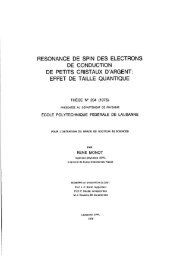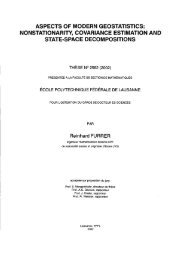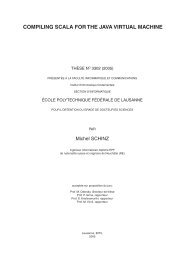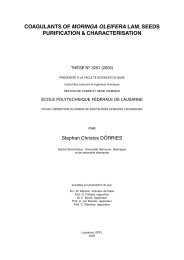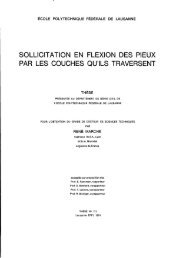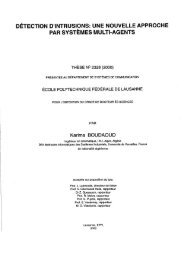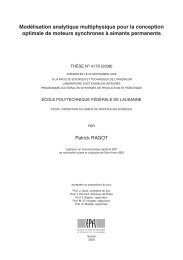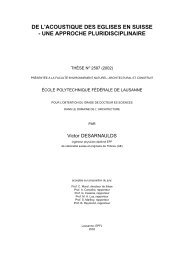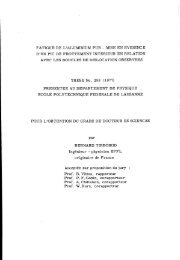retrait hygrique - EPFL
retrait hygrique - EPFL
retrait hygrique - EPFL
Create successful ePaper yourself
Turn your PDF publications into a flip-book with our unique Google optimized e-Paper software.
A NUMERICAL APPROACH TO INVESTIGATE<br />
THE PROPERTIES OF CONCRETE<br />
NUMERICAL CONCRETE<br />
THESE No 788 (1989)<br />
PRESENTEE AU DEPARTEMENT DES MATERIAUX<br />
ECOLE POLYTECHNIQUE FEDERALE DE LAUSANNE<br />
POUR L'OBTENTION DU GRADE DE DOCTEUR ES SCIENCES TECHNIQUES<br />
PAR<br />
PIETER ENGBERT ROELFSTRA<br />
Ingénieur civil diplbmé de l'université de Delft<br />
de ~av~"alj]é hollandaise<br />
acceptée sur proposition du jury :<br />
Prof. F.H. Wittmann. rapporteur<br />
Prof. A.S.G. Bruggeling. corapporteur<br />
Dr R. Dungar. corapporteur<br />
Prof. F. Frey. corapporteur<br />
Prof. C. Huet. corapporteur<br />
Lausanne. <strong>EPFL</strong><br />
1989
TABLE OF CONTENTS<br />
1. 1 ITRODUCT ION 5<br />
1.1 General remarks<br />
1.2 Aim and scope of this study<br />
1.3 Contents of this study<br />
1.4 notation<br />
2. BUMERICAL TOOLS 9<br />
2.1 Introduction 9<br />
2.2 Basic Concepts of the Boundary and Finite Blement Hethod 9<br />
2.2.1 Hathematical formulation 9<br />
2.2.2 Discretization with finite elements 11<br />
2.2.3 Discretization with boundary elements 13<br />
2.2.4 Advantages and disadvantages of the BEI with respect ta 15<br />
the FEW<br />
2.3 Cellular Automata 16<br />
2.4 Solution procedures for non-linear material and field problems 17<br />
2.4.1 Introductory reniarks 17<br />
2.4.2 Successive substitut ion 17<br />
2.4.3 Newton-Raphson 18<br />
2.4.4 Modif ied Hewton 19<br />
2.4.5 Quasi-Newton 19<br />
2.4.6 Arc- length methad 22<br />
2.4.7 Time integration (marching) schemes 23<br />
2.5 Computational aspects 27<br />
2.5.1 General re~aarks 27<br />
2.5.2 Efficient storage of element and system matrices 27<br />
2.5.3 Substructuring 28<br />
2.5.4 Solution routines 3 1<br />
3. IICRO-LEVEL 32<br />
3.1 Introduction 32<br />
3.2 Formation of the microstructure of HCP - a review 32<br />
3.2.1 Chernical coniposit ion 32<br />
3.2.2 Particle size distribution of cement clinker grains 33<br />
3.2.3 Vater/cement ratio 34<br />
3.2.4 Hydration process 35<br />
3.2.5 Porosity and pore size distribut ion 37
3.3 Storage and transport of moisture in HCP<br />
3.3.1 General remarks<br />
3.3.2 Mathematical mode1 for desorption isother~<br />
3.3.3 Moisture permeability, capacity and diffuçivity<br />
3.3.4 Simulation of drying of finitely long cylinders<br />
3.4 Hodelling of the hydration process<br />
3.4.1 Models described in the literature<br />
3.4.1.1 Reaction kinetics<br />
3.4.1.2 Particle size distribution<br />
3.4.1.3 Simulation method<br />
3,4.2 Empirical mode1<br />
3.5 Shrinkage<br />
3.5.1 Unrestrained shrinkage<br />
3.5.2 Simulation of shrinkage of drying finitely long cylinders<br />
3.5.3 Curvature of end faces of drying finitely long cylinders<br />
3.5.4 Feed-back analysis<br />
3.6 Basic creep<br />
3.6.1 Rate theory and mathematical formulation<br />
3.6.2 Experiments<br />
3.6.3 Discussion of results<br />
3.7 Drying creep<br />
3.7.1 Definition and controversial views<br />
3.7.2 Bumerical analysis of experimental results<br />
3.7.3 Conclusion about the existence of drying creep as a real<br />
mechanism<br />
4.1 Introduction<br />
4.2 Generation methods of Bumerical Concrete<br />
4.2.1 Shape characteristics of aggregate grains<br />
4.2.2 Grain size distributions and aggregate volume content<br />
4.3 Principles to obtain effective values for a composite material<br />
4.3.1 1 ntroductory remarks<br />
4.3.2 Principle to determine the effective coefficient of per-<br />
meability<br />
4.3.3 Some considerat ions<br />
4.4 Modulus of elasticitp<br />
4.4.1 Finite element idealization<br />
4.4.2 Effective cornpliance matrix<br />
4.4.3 Consistency<br />
4.5 Basic creep 99
4.6 Xoisture transport coefficients and drying<br />
4.6.1 Effective coefficient of permeability<br />
4.6.1.1 Analysis in 2D with the finite element method<br />
4.6.1.2 Analysis in 3D with the boundary element mthod<br />
4,6.1.3 Role of the Interface<br />
4.6.2 Drying process<br />
4.7 Shr inkage<br />
4.7.1 Effective final shrinkage<br />
4.7.2 Coupling between shrinkage and the drying pracess<br />
4.7.3 Shrinkage of a quasi-homgeneous material<br />
4.8 Deformation under transient thermal and hygral conditions<br />
5. HACRO-LEVEL<br />
5.1 Introduction<br />
5.2 Determination of temperature distributions, drying, and<br />
fracture<br />
5.2.1 The aim of a system of software modules: FEiûiASSE<br />
5.2.2 Temperature distributions: HEAT/l<br />
5.2.3 ltoisture distributions: WOIST/l<br />
5.2.4 Failure of concrete<br />
5.2.4.1 Fictitious crack model: FRACTURE/l<br />
5.2.4.2 Strain softening: SOFTFIT/l<br />
5.3 Computer codes for structural engineering<br />
5.3.1 The aim<br />
5.3.2 Large span bridges : CCB/2<br />
5.3.2.1 General remarks<br />
5.3.2.2 Description of the problem<br />
5.3.2.3 Analysis<br />
5.3.2.4 Results<br />
5.3.2.5 Use of a PC<br />
5.3.3 General computer code for concrete structures: STRUCON<br />
5.3.3.1 Introduction<br />
5.3.3,Z Finite element mesh adaptation for non-linear<br />
problems<br />
5.3.3.3 Procedure for event controlled failure analysis<br />
6. SUHKARY<br />
7. COACLUS 1 OHS<br />
8. REFEREBCES<br />
RESUWE<br />
ACKEOWLEDGEMEBTS
APPENDIX 1<br />
APPEHDIX II<br />
APPENDIX III<br />
CURRICULUH VITAE
6. SUMMARY<br />
The major aim of this study is to show how numerical methods can contri-<br />
bute in addition to experimntal research in the analysis and understan-<br />
ding of complex materials behaviour. Concrete has been taken as an example<br />
here, but in principle also other composite materials can be studied in a<br />
similar mannes.<br />
The 3L approach (three level approach: micro-, meso-, and macro-level) has<br />
been put forward in order to perform analyses in a systematic way. The micro<br />
level deals with the modelling of the physical and mechanical behaviour of<br />
HCP. On the aeso-level the heterogeneous character of concrete 1s taken<br />
into account by means of conputer-generated structures which resemble the<br />
real structure of concrete. These computer-generated structures are now<br />
called"Humerica1 Concrete'. Effective properties of these structures are<br />
determined by means of the finite and boundary element method, and are<br />
applied to structural analysis on the macro-level.<br />
In chapter 2 a detailed overview 1s given of the numerical methods (tools)<br />
which have been used in this study. The principles of the finite and boun-<br />
dary elemnt method are briefly explained, and the matheiratical manipula-<br />
tions are illustrated by means of the simple Laplace equation. The advan-<br />
tages and disadvantages of both mthods are discussed. Different procedures<br />
such as the successive substitution, Newton-Raphson, Modified Newton, and<br />
Quasi-Bewton to solve non-linear material and field problems are described.<br />
The concept of the arc-length method 1s briefly outlined. The explicit and<br />
implicit time marching schemes as well as the criteria for stability and<br />
convergence are explained,<br />
To stimulate the use of these methods in material science some computatio-<br />
na1 aspects such as efficient storage of element and systen rpatrices, sub-<br />
structuring techniques, and renulnbering of nodal variables are discussed. A<br />
set of helpful subroutines coded in Fortran is given in Appendix 1.<br />
The micro-level 1s described in chapter 3. The formation of the microstruc-<br />
ture of HCP is reviewed. An empirical model 1s proposed which describes the<br />
evaporable moisture content of HCP as a function of the moisture potential<br />
(relative humidity), the w,/C ratio, the temperature, and the degree of<br />
hydration. This model is based on the reliable experimsental results of<br />
Hundt and Kantelberg C 19781 .<br />
The driving forces for noisture transport are discussed and the coupled<br />
heat and moisture transport equation 1s deduced. The drying process of<br />
finitely long cylinders with and without sealed end faces 1s simulated<br />
numerical ly.<br />
Som promising aodels for the simulation of the hydration process described<br />
in the literature are discussed. An empirical =del which describes the hy-<br />
dration process under transient hygral and thernal conditions 1s presented.<br />
Vith this model the influence of the auto-dessication on the drying process<br />
1s examinad.<br />
Unrestrained hygral shrinkage 1s defined and the deformation of drying fi-<br />
nitely long cylinders ls calculated. The computed curvatures of the end<br />
faces of these cylinders are in close agreement with experimental findings.<br />
It 1s shown that the diffusion coefficient can be reconstructed from mea-
sured curvatures by means of a feed-back analysis.<br />
Easic creep is considered as a rate process and the mat.hematica1 formula-<br />
tion is given. The influence of the w,/c ratio and the moisture potential<br />
on the basic creep is determined experimentally.<br />
The influence of crack fornation on shrinkage 1s quantified. Detailed nume-<br />
rical analyses show that the difference between experimentally observed<br />
shrinkage and 'true' shrinkage (without crack formation) of loaded specimen<br />
1s too small to explain the drying creep phenomenon. The application of the<br />
mathematical formulation of this phenomenon, propobed by Bazant and Chern<br />
t19871, turns out to give consistent results.<br />
The heterogeneous character of concrete is taken into account in chapter 4.<br />
The generation methods of composite structures which resemble the real<br />
structure of concrete are explained. The principles to obtain effective<br />
values for a composite material by means of numerical analysis are given.<br />
The effective modulus of elasticity is determined as a function of the<br />
aggregate volume content and as a function of the ratio between the nnduli<br />
of elasticity of the aggregate grains and the mortar. It is shown that the<br />
computed effective values are in close agreement with those obtained by<br />
analytical models.<br />
Basic creep of composite structures is simulated and the interna1 redistri-<br />
bution of potential energies is quantified. It 1s concluded that the ob-<br />
served increase of the potential energy in the aggregrate grains during<br />
loading 1s partly responsable for the creep recovery after unloading.<br />
The effective coefficient of permeability as a function of the aggregate<br />
volume content 1s determined for 2D and 3D composite structures. The com-<br />
parison between the results shows that 2D analyses describe reasonably well<br />
the complex 3D situations.<br />
The important role of the interface between the aggregate grains and the<br />
mrtar niatrix is demnstrated. A moisture flow law 1s deduced which takes<br />
the aggregate volume content as well as the non-uniform thickness of the<br />
interface into account. The drying process of a composite structure is<br />
simulated for a normal and an elevated temperature.<br />
It turns out that the stresses caused by inhomogeneous hygral shrinkage<br />
exceed generally the tensile strength, which indicates that crack formation<br />
mst be included in the analysis.<br />
An analysis 1s performed to study the effect of thermal incompatibility<br />
between the aggregate grains and the mrtar niatrix in a loaded specimen. It<br />
turns out that an increase of temperature partly unloads the aggregate<br />
grains which causes an acceleration of the creep rate.<br />
Chapter 5 1s devoted to the rpacro-level. A system of software modules<br />
called FBMNASSE developed to promote the use of effective material laws 1s<br />
presented. The evolution of the temperature distribution in a cross section<br />
of a girder after casting its deck slab is predicted with module HEAT/l.<br />
With module HOIST/l the drying of a box-girder exposed to a variable rela-<br />
tive humidity at the outside and a constant relative humidity at the inside<br />
1s simulated.<br />
Details of module FRACTUREll, which 1s put forward to analyse crack for-<br />
mstion and propagation in simple concrete elements such as bars, beams,<br />
CT-specimen, cubes, are given. A study is mide with module FRACTURE/l to<br />
determine the influence of the position of the break point in a bi-linear<br />
stress crack width diagram on the macroscopical failure behaviour. In this
I<br />
analysis the fracture energy G, and the tensile strength ft are kept con-<br />
stant. It turns out that the limit load 1s very sensitive (almost a factor<br />
2 between the smallest and largest value) on the position of the break<br />
point.<br />
It 1s demonstrated how stress-crack width relations can be reconstructed<br />
from measured load-displacement diagranrs by means of module SOFTFIT/l.<br />
Som aspects of module CCB/2 are explained. This module is used to predict<br />
the excess heights of the shuttering of the long span bridge in Riddes<br />
(Valais, Switzerland, currenlty in construction), in order to compensate<br />
subsequent t ime-dependent def ormat ions.<br />
Two features of a general computer code for concrete structures called<br />
STRUCOH (which 1s still in full development) are discussed. The implemented<br />
mesh adaptation technique employed in non-linear analysis 1s explained. The<br />
procedure for event controlled failure analysis 1s pointed out and an<br />
example 1s given.
Dans le domine du génie civil, l'usage de codes numériques est devenu de<br />
nos jours presque routinier. Cependant, la majeure partie des codes exis-<br />
tant souffrent de certaines insufficances. En effet, des facteurs aussi<br />
importants que le fluage, le <strong>retrait</strong> <strong>hygrique</strong>, le <strong>retrait</strong> chimique, les<br />
gradients thermiques ..., pouvant influencer considerablement la durabili-<br />
té de la construction, sont souvant omis dans ces codes.<br />
Cette lacune incombe principalement au fait que les differents facteurs ci-<br />
cités sont mutuel lement dependants ce qui complique davantage l' élaboration<br />
des codes; de plus la prise en compte de tels facteurs nécessite la connais-<br />
sance des lois des matériaux aussi realistes que possibles, lois qui, à<br />
l'heure actuelle ne sont qu'approximatives ou carrément inexistantes.<br />
Le but principal de ce travail est de yntrer commeot les méthodes de cal-<br />
cul numérique avancées, combinées aux resultats experimentaux peuvent con-<br />
tribuer à une analyse réaliste et à une meilleure comprehen~ion de compor-<br />
tement du matériau. Une telle tache est devenue possib!e grace à la puis-<br />
sance, sans cesse croissante des ordinateurs de la génerat ion actue 1 le.<br />
L' élabarat ion de lois constitutives pour un matériau aussi hétérogène que<br />
le béton, se heurtera forcément à des difficultés, difficultés dictées par<br />
la complexité de sa structure.<br />
Pour mener à bien une telle étude, on adopte l'approche des trois niveaux<br />
(TL-Approch). Dans cette approche le beton est subdivisé en un système<br />
hiéarchique, composé de trois niveaux structuraux:<br />
- le micro-niveau<br />
- le meso-niveau<br />
- le macro-niveau<br />
Par souci de clareté du texte et pour traiter les sujets spécifiques d'une<br />
manière consistante, un apergu global des méthodes num'riques existantes ou<br />
developpées tout au long de ce travail est exposé au chapitre 2.<br />
Le micro-niveau<br />
Un modèle empirique, décrivant la teneur en eau éqaporable dans la matrice<br />
de de ciment durcie en fonction de l'humidite relative pour différents<br />
rapports E/C, températures et de& d'hydratation, a 4th proposé. Ce m-<br />
dèle est basé sur les résultats expérimntaux de Hundt et Kantelberg i 19781.<br />
évolution du degré d'hydratation, dans des conditions <strong>hygrique</strong>s et ther-<br />
miques transitoires, a été modelée. L' influence de 1' auto-dessication sur<br />
la vitesse d'hydratation a été étudi6,<br />
La simulation numérique de la déformation des faces d'un cylindre séchant a<br />
montré un bon agréement avec les résultats expérimentaux obtenus par la<br />
dthode d' interferometrie holographique.
Ceci signifie que les méthodes numériques et les lois des matériaux utili-<br />
sées étaient consistentes. Un modèle, particulièrement original a été<br />
developpe pour reconstruire la relation entre le coefficient de diffusion<br />
et l'humidité relative à partir des courbures mesurées des faces d'un<br />
cylindre séchant ., Cette technique donne un example concret de 1' application<br />
des méthodes numeriques sur des résultats expérimentaux pour extraire des<br />
lois des materiaux.<br />
L'influence de la fissuration sur le <strong>retrait</strong> <strong>hygrique</strong> a été quantifiée. Les<br />
analyses numériques ont rélévé que la dif ference entre le <strong>retrait</strong> observé<br />
expérimentalement et le <strong>retrait</strong> ' vrai' (i. e. sans formation de fissures)<br />
d' un sp6cimen séchant et chargé est trop faible pour pouvoir expliquer le<br />
fluage ,induit par le sechage. Ainsi, la formula$ion analytique du phéno&ne<br />
proposee par Bazant et Chern 119871 est justifiee.<br />
Le meso-niveau<br />
Des structures composites, représentatives de la structure réelle du béton<br />
peuvent être générées par différents codes développes. Les données néces-<br />
saires a la génération de ces structures sont: la morphologie des granulats,<br />
la distribution granulodtrique et la teneur volumique relative des granu-<br />
lats intervenant dans la composition du béton dont on veut simuler la struc-<br />
ture.<br />
Les lois des matériaux relatives à la matrice qui ont 6th étudiées au<br />
micro-niveau seront introduites dans ce kso-niveau pour évaluer les facteurs<br />
effectifs du béton.<br />
/<br />
Ainsi, au moyen d'une analyse numerique appropriée des structures composi-<br />
tes générées. les variations des propriétés,ef fectives suivantes ont 4th<br />
étudiées en fonction de la composition du beton:<br />
- perdabi 1 ite hygrigue<br />
- mdule d'élasticite et coefficient de Poisson<br />
- <strong>retrait</strong> <strong>hygrique</strong> (sans fissuration><br />
- dilatation thermique<br />
I I I \<br />
Les valeurs effectives calculees revelerent une bonne concordance avec les<br />
modèles analytiques et les resyltats expérimentaux. Cette mdél isat ion<br />
nudrique de la structure du beton a cependant des avantages indéniables<br />
sur les mdeles a?alytiques. En effet des facteurs structurels, aussi im-<br />
portants 9ue la geometrie des granulats, la distribution granulom'triqw,<br />
1 ' i nhomgenéite ou 1' orthotropie de 1 ' une ou 1' autre phase, peuvent aisé-<br />
ment être pris en considération, alors qu'ils sont souvent absents dans les<br />
théories analytiques traitant des matériaux mu1 t iphasiques.<br />
La comparaison entre,les r&ultats
- fluage de base<br />
- sechage a des températures variables<br />
1 - <strong>retrait</strong> <strong>hygrique</strong> (sans fissuration)<br />
- déformation totale d'un spécimen sous charge, placé dans des conditions<br />
therm-<strong>hygrique</strong>s variables<br />
La simulation du fluage de base dans une structure composite a montré que<br />
1 ' énergie potentiel le totale eimagazinée dans les granulats ?ugmentait.<br />
ceci expliqu? partiellement le fluage réversible observé experimentalement<br />
lors de la decharge d'un spécimen de béton. Les contraintes calculées occa-<br />
sionnées par le <strong>retrait</strong> ?nhomgene induit par le processus de séchage,<br />
excédent en général la resistance a la traction de la matrice. Ceci signi-<br />
fie que la formation de fissures doit être prise en compte dans de telles<br />
ana lyses.<br />
Une augmentation de température tend a accélérer le processus de séchage.<br />
L'analyse de l'état des contraintes dans une telle situation montre que les<br />
granulats sont partiellement déchargés à cause de 1' incompat ibi lite ther-<br />
mique des constituants dans une structure chargée. Ceci est une des raisons<br />
pour lesquelles la vitesse du fluage augmente dans de tels cas.<br />
A ce stade, les informations recueillies aux micro- et dso-niveaux sont<br />
uqilisées dans les calculs relatifs au macro-niveau, niveau ou le matériau<br />
beton est consideré comme homogène.<br />
Un systène de logiciels, déno- 'FEWIIASSE', a été développé. Un tel sys-<br />
tème permet de calculer, par example, les distributions de températures ou<br />
d'humidité relative dans une section d'une construction placée dans des<br />
conditions thfrmo-hygriq~es quelconques. Ces champs thermiques ou hygri-<br />
ques peuvent etre utilises dans une analyse du comportement de la struc-<br />
ture en fontion du temps.<br />
Un logiciel sp~cial, 'SûFTFIT/l', a été développé dans le but de recon-<br />
struire la relatioq contrainte-ouvert,ure au fond delfissure a partir du<br />
diagramme ef fort-def ormat ion de differents types d' eprouvettes entaillées.<br />
Avec le logiciel CCB/2 les surhaussements du coffrage d' un pont à longue<br />
actuellea~nt eq construction à Riddes, Valais, ont été predits, à<br />
fin de compenser les deformations différées après mise en service.<br />
Deux aspects d'un logiciel, dénommé 'STRUCOE' (toujours en plein dévelop-<br />
pement) sont présentés: la technique d' adaptation du maillage des éléments<br />
finis utilisée dans 1' analyse non-lineaire et 1' analyse de ruine controlée<br />
par evenement .



